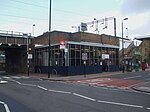Walthamstow ( or ) is a large town in east London, England, within the ceremonial county of Greater London and the ancient county of Essex. Situated 7+1⁄2 miles (12 kilometres) northeast of Charing Cross, the town borders Chingford to the north, Snaresbrook and South Woodford to the east, Leyton and Leytonstone to the south, and Tottenham to the west. At the 2011 census, the town had a population of approximately 109,424.
Occupying most of the town's east-to-west High Street, Walthamstow Market is the longest outdoor market in Europe. East of the town centre is Walthamstow Village, the oldest part of Walthamstow, and the location of St Mary's Church, the town's parish church. To the north of the town is the former Walthamstow Stadium, which was considered an East End landmark. The William Morris Gallery in Forest Road, a museum that was once the family home of William Morris, is a Grade II* listed building. The town is served by five railway stations, including Walthamstow Central and Blackhorse Road—interchange stations on the Victoria line of the London Underground.
The administrative centre of the London Borough of Waltham Forest, a local government district of Greater London, Walthamstow was a civil parish, originally part of the Becontree Hundred of Essex. Similar to much of south-west Essex, the town expanded rapidly in the 19th century, becoming a suburb in the urban area of London. It has formed part of the Metropolitan Police District since 1840, and the London postal district since its inception in 1856. The parish became a local board district in 1873, an urban district in 1894 and a municipal borough in 1929. Following reform of local government in London in 1965, it merged with the municipal boroughs of Chingford and Leyton to form the new Waltham Forest local authority district, moving from the administrative county of Essex to the newly-formed Greater London council area. The borough council is based at the former Walthamstow Town Hall in Forest Road.





